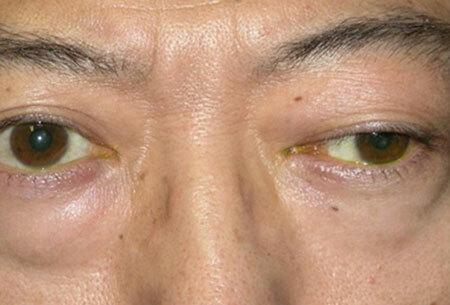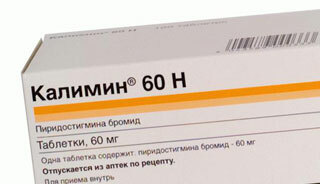The work of all muscles in the body of a healthy person is innervated by nerve endings, that is, the nervous system sends a certain impulse that acts directly on the muscle fiber, as a result of which it contracts or relaxes.
When a failure occurs in the transmission of these impulses, various diseases arise, one of which is myasthenia gravis.
Contents of
- 1 Myasthenia gravis - what is it?
- 2 Causes of myasthenia gravis
- 3 Symptoms of myasthenia gravis, characteristic features
- 4 Myasthenia gravis diagnosis
- 5 Myasthenia gravis treatment, preparations
Myasthenia gravis - what is it?
Myasthenia gravis is a disease of an autoimmune origin, manifested by a violation of the transmission of muscular-nerve impulses, as a result of which the patient breaks the pathological muscle weakness, against which he can not perform the usual actions and even minimal physical exertion. This pathology is more common in women than in men, and it affects people of young age - from 20 to 35 years.

symptoms of myasthenia gravis, photo
The danger of the disease is the frequent development of so-called myasthenic crises, which can result in death for the patient.
Myasthenia gravis has two forms - congenital and acquired.
Congenital form of disease occurs due to mutation of protein genes in the process of embryogenesis, which are responsible for the transfer of muscle-nerve impulses. The disease manifests itself immediately after the birth of the baby, in the first minutes of his life, and is characterized by a violation of the respiratory function. The prognosis for congenital myasthenia gravis is extremely unfavorable, most often the child dies.
Acquired form of the disease occurs more often, it develops as a result of the influence on the human body of unfavorable factors: the transferred infections, stress, hormonal disorders and malfunction of the immune system.
This form of myasthenia gravis is characterized by a malfunction of the human immune system, as a result of the thymus gland, large amounts of antibodies are produced that kill their own cells.
The acquired form of myasthenia gravis is often also called the thymus tumor( thymus gland), as against the background of the pathological process of iron, it increases substantially in size.
Causes of myasthenia gravis
The causes of myasthenia gravis acquired form have not been studied to the end, but scientists have determined that predisposing factors of this pathology are:
- Hormonal disorders;
- Constant stress;
- Some medications that affect the musculoskeletal synapse;
- Post-cold or infectious diseases;
- Tumors of the lungs, breast and other organs that can provoke increased thymic function and glandular hyperplasia.
Symptoms of myasthenia gravis, characteristic features of

Myasthenia gravis develops in most cases suddenly in the form of a crisis, which is very frightening for patients. The development of the clinical picture of the disease can be triggered by increased physical stress, experienced stress, a prolonged stay in hot weather under the open sunlight.
Most often, patients develop ocular myasthenia gravis, which is clinically manifested as follows:
- Osteoplasty( ptosis);
- Doubling in the eyes.
Along with this, the facial, facial, chewing and muscles of the limbs are affected, which is characterized by the development of a number of symptoms:
- Difficulty swallowing or chewing, feeling lump in the throat;
- Change in voice( hoarseness, hoarseness) or complete loss of voice;
- Intensified salivation, which the patient can not control;
- Gait of gait;
- Weakness in the limbs, as a result of which the patient can not service himself and move normally;
- Distortion of facial expressions;
- Impossibility to keep the head in the right position, since the muscles of the neck are affected;
- Paralysis of the extremities.
In most cases, the disease gradually leads to the development of disability, as myasthenia gravis is constantly progressing and eventually passes into complete atrophy of the affected muscles.
Diagnosis of myasthenia gravis
In order to correctly diagnose a patient, a complex examination is prescribed, as the clinical picture of myasthenia gravis may be similar to other diseases. The main diagnostic methods are:
- Detailed biochemical blood tests for the detection of antibodies;
- Genetic screening, which is performed to identify the congenital form of myasthenia gravis;
- Electromyography is a study in which it is possible to evaluate the potential of muscle fibers when they are excited;
- MRI - with the help of this study, you can see even the most insignificant signs of hyperplasia of the thymus gland;
- Electro-neurology is a study that assesses the rate of transmission of nerve impulses to muscle fibers;
- Prozerin test - the patient is injected subcutaneously with proserin, after which they wait for up to half an hour, and then the result is evaluated. Myasthenia sufferers feel a significant improvement in their condition, and after a few hours the clinical symptoms resume with the same strength;
- Test for muscle fatigue - the patient is asked to quickly open and close the mouth several times, waving his arms and legs, squeeze and unclench the brushes, squat. The main syndrome of myasthenia gravis is the appearance of increasing muscle weakness when these movements are repeated.
Treatment of myasthenia gravis, drugs
 Myasthenia gravis is a chronic disease - it means that you can not completely cure the pathology, but the patient is able to achieve a stable remission, so that the quality of life will be higher. Treatment of myasthenia gravis is carried out for years, allocates the most effective drugs for myasthenia gravis:
Myasthenia gravis is a chronic disease - it means that you can not completely cure the pathology, but the patient is able to achieve a stable remission, so that the quality of life will be higher. Treatment of myasthenia gravis is carried out for years, allocates the most effective drugs for myasthenia gravis:
- Prozerin;
- Calimine;
- Galantamine.
These drugs are similar in their therapeutic effect, only the duration of their effects on the body differs. All these medicines may be prescribed only by a specialist, after a preliminary comprehensive examination and confirmation of the diagnosis.
In addition to the main treatment of myasthenia with anticholinesterases, the patient is additionally prescribed drugs with a high content of potassium and a diet consisting of products rich in this trace element( dried apricots, potatoes, dates, raisins).
In the period of exacerbation of the disease and the development of myasthenic crises, the patient is prescribed glucocorticosteroid therapy, the dose of which is determined strictly individually, depending on the characteristics of the organism and the severity of the clinical picture.
If the thymus tumor progresses and the clinical picture of the disease is worsened, the patient is shown to undergo surgery and irradiation of the thymus gland.
In the stage of persistent remission, the patient should follow several recommendations that will avoid exacerbation and progression of myasthenia gravis:
- Avoid stress and physical overwork;
- Do not stay for a long time under the open rays of the sun;
- Any medicinal products should be taken only as directed by a physician;
- Regularly undergo preventive examinations with a doctor.



